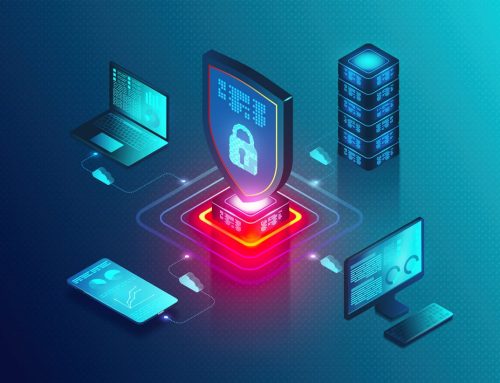In the ever-changing landscape of retail, businesses face a mix of retail security challenges – from old-school shoplifting to sophisticated cyber threats. Today’s retail security demands a comprehensive strategy that recognizes and addresses vulnerabilities across the entire spectrum. Whether it’s safeguarding tangible assets in stores to fortifying virtual perimeters that protect sensitive customer data, enhancing your retail security is crucial.
Effective security measures aren’t just a proactive response. They’re a must for the ongoing success and trustworthiness of retail operations. It’s not only about securing tangible items—it’s also about ensuring the integrity of your business, both in the physical and virtual realms.
Common Threats in Retail Security

Understanding common threats to retail security is the first step to implementing strategies to prevent them. Among the most common threats are shoplifting, cyber security, and employee theft.
Traditional shoplifting involves people attempting to steal merchandise without detection. This poses a significant challenge to retailers’ revenue and requires robust surveillance and loss prevention measures. Along with shoplifting, organized retail crime has begun to increase, involving coordinated efforts by organized groups to engage in larger-scale theft, fraud, and illicit activities.
Employee theft and internal fraud present internal challenges for retailers, involving dishonest practices by employees, such as theft or unauthorized access to sensitive information. Balancing trust and oversight becomes crucial in identifying and preventing these internal threats. Businesses can prioritize thorough background checks, strict access controls, and a corporate culture that emphasizes integrity and ethical conduct.
Physical security breaches, including break-ins, vandalism, and unauthorized access to restricted areas, pose threats to the safety of retail establishments. Combating these physical security challenges involves a combination of technology, personnel, and procedural measures. These can include installation of surveillance cameras, access control systems, alarm systems, and comprehensive training for security personnel.
Beyond just physical threats, like employee theft and organized crime, cyber threats have become a prevalent concern for retailers. These threats encompass various risks, including point-of-sale system breaches, phishing attacks, and data breaches targeting customer information and payment details. The increasing digitization of retail operations demands rigorous cybersecurity measures, employee training, and regular security audits to safeguard customer trust and data security.
In addressing these common threats, retailers should incorporate advanced technologies, employee training, cybersecurity measures, and collaborative efforts with law enforcement to create a secure environment for both physical and digital retail operations.
The Cost of Poor Retail Security
The cost of poor retail security extends far beyond immediate financial losses and can have long-lasting repercussions for businesses. Knowing the consequences for having poor retail security is crucial for retailers to recognize the importance of investing in new technologies and security practices.
Financial Losses
The immediate and most obvious consequence of poor retail security is financial losses. These losses can result from theft, fraud, or other activities that take away merchandising and operations. Not only do retailers face the direct cost of stolen merchandise, but they also incur expenses related to investigations, insurance claims, and potential compensation for affected parties.
Reputation Damage
Instances of theft or security breaches can lead to negative publicity, eroding consumer confidence in the store’s ability to provide a secure shopping environment. A damaged reputation may result in a loss of customer goodwill. This can be particularly detrimental in an age where online reviews and social media can amplify negative experiences, potentially dissuading new customers from engaging with the company.
Customer Loss
As a direct consequence of reputation damage and concerns about security, retailers may experience a decline in customer retention and acquisition. Consumers are likely to choose competitors perceived as more secure and reliable, leading to a decrease in foot traffic and sales.
Legal Consequences
Poor retail security can expose businesses to legal liabilities. If customers or employees are harmed due to security lapses, retailers may face lawsuits, legal claims, and regulatory penalties. Compliance with industry standards and legal requirements is crucial to avoiding legal consequences.
Supply Chain Disruptions
These disruptions not only affect a retailer’s ability to meet customer demand promptly but also strain relationships with suppliers and logistics partners, potentially leading to increased costs and operational inefficiencies. For example, theft or security breaches at distribution centers can lead to inventory shortages, delayed deliveries, and increased transportation costs.
How to Improve Your Retail Security

Improving retail security is essential to safeguard assets, maintain customer trust, and ensure the overall integrity of the business.
Physical Measures
Ensuring the physical security of a retail store is important to deter theft and unauthorized access. Implementing visible security measures such as surveillance cameras, alarms, and anti-shoplifting devices create some deterrents. Proper lighting in and around the premises also enhances the overall safety of the area and discourages criminal activities.
Technological Solutions
Embracing cutting-edge technological solutions is instrumental in fortifying retail security. High-quality surveillance cameras equipped with facial recognition and advanced analytics can help improve monitoring capabilities, which enables quicker identification of suspicious individuals.
Electronic article surveillance systems, RFID technology, and smart shelving provide real-time tracking of merchandise, preventing theft and minimizing inventory shrinkage. Secure point-of-sale (POS) systems, fortified with encryption for customer data, protect against cyber threats and unauthorized access to sensitive information.
The integration of cell phone detection and RF finder technology can aid in monitoring and preventing potential shoplifting attempts, enhancing the effectiveness of security measures. These technologies not only improve the overall security posture but also contribute to a more efficient and streamlined retail operation.
Employee Training
Employees serve as the first line of defense in any retail security strategy. Establishing a comprehensive training program is crucial to empower staff in identifying and responding to potential threats.
Training should cover how to recognize suspicious behavior, ways to utilize security systems effectively, and how to follow emergency response protocols. Cultivating a culture of security awareness among employees helps create a vigilant workforce, reducing the risk of internal theft and other security breaches.
Collaboration with Law Enforcement
Building a collaborative relationship with local law enforcement can help enhance a retailer’s ability to respond effectively to security threats. Establishing open lines of communication and sharing information about potential threats facilitates quicker responses and apprehension of criminals. Coordinating efforts with law enforcement not only contributes to a safer retail environment but also creates a deterrent for criminal activities.
Data Security
Protecting sensitive customer information and payment data is paramount in the digital age. Implementing robust data security measures, including encryption, secure networks, and regular system updates, safeguards against cyber threats. Restricting access to customer data on a need-to-know basis and employing secure payment processing systems are essential components of a comprehensive data security strategy.
Using cell phone detection can further enhance data security by identifying and preventing potential threats related to unauthorized devices or attempts at electronic theft. These provide an additional layer of protection against evolving cyber threats.
How to Adapt to Evolving Threats to Retail Security
Staying ahead of threats to retail security requires the constant adaptation and integration of new technologies and employee protocols. For retailers looking to bolster their security measures, partnering with companies like Cellbusters that offer advanced cell phone detection solutions can provide an additional layer of protection.
This technology improves the ability to identify and manage potential threats posed by unknown cell phones and devices, helping to create a safer and more secure retail environment. If you’d like to learn more about our retail security solutions, contact us today.







